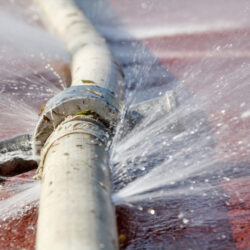Independent audits expose supply chain leaks

Of all goods flowing through retail supply chains, 2.1% fail to make it through unscathed due to errors by suppliers and retailers while delivering, receiving, picking and loading those goods. Independent random checks can uncover these errors, according to a webinar by Supply Chain Media in partnership with Retail & Asset Solutions: “The supply chain is like a leaky water pipe.”
By Marcel te Lindert
Which supply chain process is most responsible for problems with the availability of goods? Is it the delivery of goods by suppliers, goods receipt at the distribution centre, order picking at the distribution centre, or dispatch and loading orders onto trucks? When asked this question during a recent Webinar Wednesday, none of the participants chose the second option – goods receipt at the distribution centre – even though that is where the biggest problems arise. At least, that’s the findings of the five million spot checks conducted by Retail & Asset Solutions (RAS) each year in UK retail distribution centres.
Faisal Ashfaq, Head of Supply Chain at RAS, was not surprised that no one chose goods receipt. “Many retailers try to blame suppliers, but suppliers will say that they picked and shipped the goods correctly and that the fault actually lies with the retailer,” he said. “And indeed, it regularly happens that goods are delivered correctly but then errors occur during the goods receipt process. Red apples are entered as green apples, or the apples are put away in the wrong storage location.”
Leaks in the supply chain
Needless to say, an unreliable goods receipt process is not the only reason for the poor availability of goods. All four processes contribute to that, Ashfaq explained: “You can think of the supply chain as an interconnected system of water pipes and tanks. That system is full of leaks where the water can seep out. Those leaks occur because of faulty processes and systems, or because of human errors. Plugging just the first leak with your finger isn’t enough. That only forces more water out of the other leaks. You have to address the entire network of pipes.”
RAS provides services that help ensure that goods reach customers with as few problems as possible. The company sends auditors to distribution centres to verify that goods are delivered, received, picked and shipped correctly. These independent spot checks reveal not only the errors, but also their causes. That enables the retailers to take steps to improve the availability of goods. “We work for 94% of retail formats in the UK and we’re now trying to get a foothold with this unique service in continental Europe,” Ashfaq commented.
Good Faith Receiving
The added value of independent checks is evident in the discussions surrounding goods receipt. When retailers receive too many or too few goods, a lot of correspondence and bureaucracy is involved in identifying and rectifying the error. “That’s why we’ve established a process that is fair to both suppliers and retailers, while also improving efficiency. That process is called Good Faith Receiving, and it has already been implemented by eight of the ten largest UK retailers, with a total of 700 suppliers between them,” Ashfaq continued.
The principles of Good Faith Receiving mean that suppliers can leave immediately after unloading their goods; they don’t need to wait for the retailer to verify the delivery. This saves a considerable amount of time. After delivery, the supplier sends an invoice and the retailer processes it without any queries. Meanwhile, the auditors from RAS perform quarterly spot checks on approximately 5% of the goods delivered. If these checks reveal that too many or too few goods have been delivered, the supplier and retailer settle the difference at the end of the quarter. “These spot checks are representative of the remaining 95%. And because the audit is conducted independently, both the supplier and the retailer accept the outcome without question.”
Loading roll cages
Good Faith Receiving allows for faster and more efficient goods receipt and reduces the administrative burden. Suppliers and retailers work together in good faith, which boosts the relationship between them. Overall, this approach results in better root cause conversations and error prevention. RAS figures show that within a year of implementing Good Faith Receiving, the number of errors drops by 60%. The decline is greatest in the fashion sector. “But that is also the sector with the highest error rate. It often involves items in different sizes and colours, so mistakes are easily made,” Ashfaq stated.
RAS also provides independent spot checks for order picking or direct delivery to stores. Consolidating goods for dispatch and loading trucks is the most underestimated process. “If you make a mistake during order picking, it only affects one product. But if you make a mistake loading a roll cage, it immediately affects 20, 50, 100 or 200 products. A major British retailer discovered that 3% of all its load containers were taken to the wrong store. That has a big impact on the stock in those stores,” he added. “We check not only whether the right load containers end up in the right stores, but also whether they are unloaded in the right stores.”
2.1% impact overall
Taken together, all the errors reduce the availability of goods by 2.1% overall. In other words, 2.1% of customers won’t buy anything because they can’t find the desired product in the store, or they are forced to choose a different product – such as buying red apples because green ones are out of stock. Ashfaq: “These are errors that often go unnoticed if you don’t perform regular checks. The benefits of those checks far outweigh the costs. And they take you closer to the goal of having the right quantities of the right products available in the right place at the right time.”









